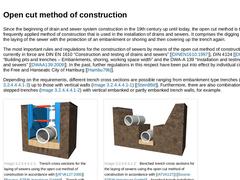
|
Since the beginning of drain and sewer system construction in the 19th century up until today, the open cut method is the most frequently applied method of construction that is used in the installation of drains and sewers. It comprises the digging of a trench, the laying of the sewer with the protection of an embankment or shoring and then covering up the trench again. The most important rules and regulations for the construction of sewers by means … |
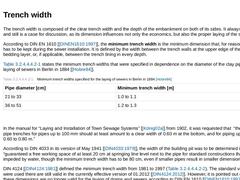
|
The trench width is composed of the clear trench width and the depth of the embankment on both of its sides. It always has been and still is a case for discussion, as its dimension influences not only the economics, but also the proper laying of the sewer. According to DIN EN 1610 [ [DINEN1610:1997]], the minimum trench width is the minimum dimension that, for reasons of safety, has to be kept during the sewer installation. It is defined by the width … |
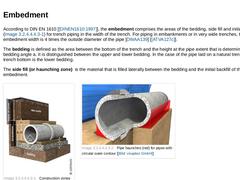
|
According to DIN EN 1610 [ [DINEN1610:1997]], the embedment comprises the areas of the bedding, side fill and initial backfill (Image 1‑43) for trench piping in the width of the trench. For piping in embankments or in very wide trenches, the embedment width is 4 times the outside diameter of the pipe [ [DWAA139:2009]] [ [ATVA127c]]. The bedding is defined as the area between the bottom of the trench and the height at the pipe extent that is determined … |
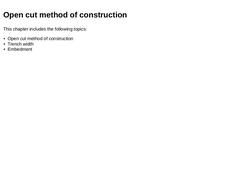
|
|
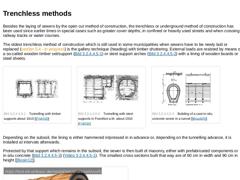
|
Besides the laying of sewers by the open cut method of construction, the trenchless or underground method of construction has been used since earlier times in special cases such as greater cover depths, in confined or heavily used streets and when crossing railway tracks or water courses. The oldest trenchless method of construction which is still used in some municipalities when sewers have to be newly laid or replaced (section 5.4 - in progress) … |

|
|
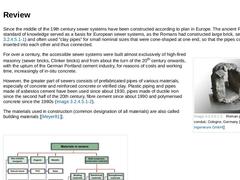
|
Since the middle of the 19th century sewer systems have been constructed according to plan in Europe. The ancient Romans’ high standard of knowledge served as a basis for European sewer systems, as the Romans had constructed large brick, sewers (Image 1‑77) and often used “clay pipes” for small nominal sizes that were cone-shaped at one end, so that the pipes could be inserted into each other and thus connected. (Image: Roman potable water conduit, … |
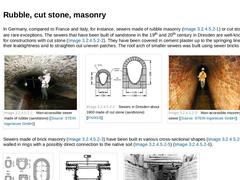
|
In Germany, compared to France and Italy, for instance, sewers made of rubble masonry (Image 1‑83) or cut stone masonry are rare exceptions. The sewers that have been built of sandstone in the 19th and 20th century in Dresden are well-known examples for constructions with cut stone (Image 1‑84). They have been covered in cement plaster up to the springing line to achieve their leaktightness and to straighten out uneven patches. The roof arch of smaller … |
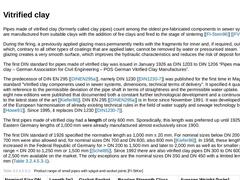
|
Pipes made of vitrified clay (formerly called clay pipes) count among the oldest pre-fabricated components in sewer systems. They are manufactured from suitable clays with the addition of fire clays and fired to the stage of sintering [ [FI-Stein96]] [ [FVS78]]. During the firing, a previously applied glazing mass permanently melts with the fragments for inner and, if required, outer glazing, which, contrary to all other types of coatings that are … |

|
Pipes of plastic materials have been utilised in sewage technology since the 1930s. Today, they are not only applied when sewers have to be newly laid, but particularly also when drains and sewers have to be renovated (section 5.3 - in process). Besides the type of plastics, the following principles of construction are also differentiated [ [KRV00]]: -
Solid wall pipe systems ( (Solid wall pipe systems)),
-
Multi-layer pipe systems ( (Systems with profiled …
|
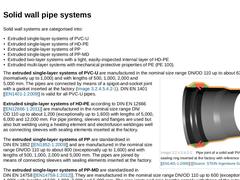
|
Solid wall systems are categorised into: -
Extruded single-layer systems of PVC-U
-
Extruded single-layer systems of HD-PE
-
Extruded single-layer systems of PP
-
Extruded single-layer systems of PP-MD
-
Extruded two-layer systems with a light, easily-inspected internal layer of HD-PE
-
Extruded multi-layer systems with mechanical protective properties of PE (PE 100).
(Image: Pipe joint of a solid wall PVC-U pipe with a sealing ring inserted at the factory … |
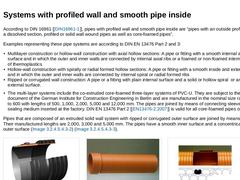
|
According to DIN 16961 [ [DIN16961-1]], pipes with profiled wall and smooth pipe inside are “pipes with an outside profile, pipes with a dissolved section, profiled or solid wall wound pipes as well as core-foamed pipes”. Examples representing these pipe systems are according to DIN EN 13476 Part 2 and 3: -
Multilayer construction or hollow-wall construction with axial hollow sections: A pipe or fitting with a smooth internal and external surface and …
|

|
|
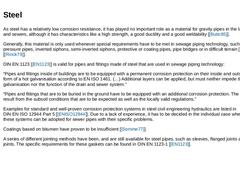
|
As steel has a relatively low corrosion resistance, it has played no important role as a material for gravity pipes in the laying of drains and sewers, although it has characteristics like a high strength, a good ductility and a good weldability [ [Buttc85]]. Generally, this material is only used whenever special requirements have to be met in sewage piping technology, such as for pressure pipes, inverted siphons, semi-inverted siphons, protective … |
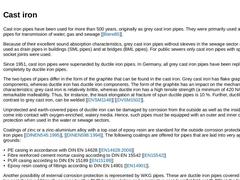
|
Cast iron pipes have been used for more than 500 years, originally as grey cast iron pipes. They were primarily used as pressure pipes for transmission of water, gas and sewage [ [Biere85]]. Because of their excellent sound absorption characteristics, grey cast iron pipes without sleeves in the sewage sector are primarily used as drain pipes in buildings (SML pipes) and at bridges (BML pipes). For public sewers only cast iron pipes with spigot-and-… |

|
According to [ [Schor83b]], concrete is a construction material composed of natural or artificial crushed granules which are encased by a binder in the liquid condition (fresh concrete) and are permanently cemented by it after the binder has hardened (hard concrete). The following specifications are directly related to cement concretes which have cement as their binders. The production of concrete pipes started in Germany about 1850, immediately after … |

|
In the beginning, the production range of concrete pipes comprised a circular cross section with or without base in nominal size ranges of 75 mm to 1,000 mm as well as pipes with ovoid cross sections of various forms and dimensions of 200/300 to 1,000/1,500. Image 1‑112 shows shapes that were common about 1912. For reasons of a facilitated transport, pipes of smaller nominal sizes were made in one piece, while larger nominal sizes were manufactured … |

|
Pipes of reinforced concrete (in the past also called reinforced concrete pipes) have been available since the 1880s. The relatively small wall thickness that resulted in weight reduction led to factory-made reinforced concrete pipes with circular cross section up to DN 2,500 already at the beginning of the 20th century. Pipes with smaller nominal sizes were often reinforced in only one direction, larger ones received spiral reinforcement, very large … |

|
The advantages of various materials are combined in concrete and reinforced concrete pipes with a corrosion protection applied directly during the production of the pipes for use in sewer systems with unavoidable and constantly "very strong" chemical aggressors according to DIN 4030 [ [DIN4030-1:1991]] and DWA-M 168 [ [DWAM168:2010]] ( (Surface damage (BAF))) . These pipes are composed of two layers, the carrier layer on the outside and the corrosion … |

|
(Image: In-situ concrete sewer of 1910 with lined bottom (Frühling, 1910))The large pipe diameters of prefabricated pipes inevitably lead to high transport weights that require heavy transport and lifting machinery. This was the reason for the very early production of in-situ concrete sewers with ovoid cross sections greater than 1,000/1,500 or circular cross sections > DN 2,000 by the open cut method of construction involving the use of special … |

|
|

|
Polymerised concrete consists of a mixture of mineral, quartzite fillers in the minimally porous grading curve range according to DIN 1045‑2 [ [DIN1045-2:2001]] and reaction resin based on unsaturated polyester resins with properties according to DIN 16946 Part 2, Table 3 [ [DIN16946-2:1989]]. The following list [ [Meyer2012]] illustrates the material characteristics of polymerised concrete for the example of POLYCRETE® pipes -
Weight per unit volume […
|

|
From about 1930 up to the end of the 1980s, asbestos cement pipes produced by the winding process from a homogeneous mixture of asbestos, cement and water were used in sewer systems [ [Asbest77]]. A survey of standards, nominal sizes and areas of application for asbestos cement pipes is given in Table 1‑58. (Table: Survey of standards and areas of application for asbestos cement pipes according to DIN 2410 Part 4 (02.78) (DIN2410)) Because of the method … |

|
Pipes made of glass fibre reinforced plastics (GRP) have been produced since the start of the 1960s. Originally, they were used for the discharge of aggressive effluents in industrial undertakings but then became increasingly important in the sewage sector where they are laid today by means of the open cut method [ [Bloom84]] [ [Bloom86]] [ [Jacob82]] as gravity or pressure piping (DN 100 to DN 3,600; Length: 6 m, Pressure up to PN 25) and by means … |

|
|